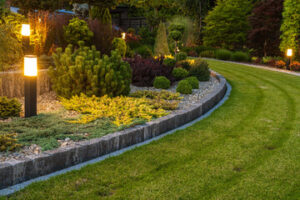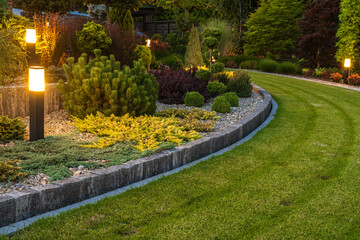Landscape lighting allows homeowners to enjoy their outdoor spaces after dark, creating a unique ambiance and highlighting key features. It’s important to understand the best practices for installing and maintaining these systems.
Begin by clearing the installation area of all debris and vegetation. This is critical to preventing hazards like buried wires or irrigation lines. Visit https://orlandolandscapelighting.net/ to learn more.
 Landscape lighting is a complex art form that requires a combination of knowledge, an eye for design, and a deep understanding of how light interacts with your property. Whether you are highlighting an important tree, shrub, or flower bed, it’s important to balance the amount of light you use to keep your property inviting without overpowering it with too much brightness.
Landscape lighting is a complex art form that requires a combination of knowledge, an eye for design, and a deep understanding of how light interacts with your property. Whether you are highlighting an important tree, shrub, or flower bed, it’s important to balance the amount of light you use to keep your property inviting without overpowering it with too much brightness.
Incorporating different techniques into your design can highlight certain aspects of a landscape, creating depth and drawing attention to unique architectural elements like boulders and retaining walls. Using the correct color of lights is also critical – warm white light can create a cozy feel, while cooler tones can give off a modern, sleek vibe. In 2024, there’s a move towards sustainability and dark sky-compliant fixtures that minimize light pollution and protect nocturnal wildlife.
Pathway lighting is often the most commonly used type of landscape lighting. These are small posts with canopies that reflect light downwards into pathways or flower beds. They are ideal for illuminating stairways and steps, as they are designed to provide ample lighting while keeping the ground surface safe at night.
Wash or grazing lighting is another popular technique that highlights the texture of a landscape feature by casting a soft glow on its surface. This style of lighting is ideal for highlighting planters, benches, and water features. In addition, grazing can also be used to highlight the silhouette of a tall tree or other structure.
Up-lighting is a more basic type of landscaping lighting that involves placing lights below or near the ground and shining them upwards to highlight plants, statues, or other structures. This style of lighting can be accomplished with spotlights, well lights, or a variety of other types of landscape lighting fixtures.
Creating a beautiful, inviting landscape after dark is an effective way to increase the value of your property and provide safety for family and guests. Well-lit walkways and entryways deter unwanted trespassers while making your property more welcoming to friends and visitors. In addition, highlighting trees and other landscape features serves as a natural deterrent to potential intruders.
Installation
The installation of landscape lighting requires a significant amount of work, planning, and equipment. It is best left to professionals, who are experienced in the process and understand how to safely and effectively implement a landscape lighting plan. A quality installation can transform your home and outdoor space into a warm and inviting area that will be used day or night.
Before starting the installation of your new landscape lighting system, it is important to identify potential hazards and obstacles that may interfere with the project. This step is essential to ensure that the proper safety precautions are taken, and it can save you from costly mistakes. It is also important to know whether your local government requires a permit for this type of work.
A good landscape lighting designer can help you create a design that is both functional and beautiful. They can also provide you with options that are eco-friendly and affordable, which is important for homeowners who want to minimize their carbon footprint. They can even install lights that will enhance your home’s curb appeal.
Once you have a plan in place, the installers will need to begin digging trenches to lay out the wiring. They will need a trenching shovel that has a narrow blade to minimize soil disturbance and avoid damage to plants. They will also need wire fish tape and a garden edger to make clean lines in the trenches. It is important to take the time to prepare for this phase of the project because any obstacles can add time and cost to the overall project.
One of the biggest reasons that homeowners get landscape lighting is to improve their curb appeal. However, this is often not the most practical application for these lights. It can be easy to get caught up in the idea of illuminating your great new pergola, your palm tree, or that lovely archway entryway, but remember to consider functionality too. Having well-lit walkways and entrances can prevent accidents, while it will also allow you to use your outdoor spaces after dark without having to trip over skateboards or other objects that are left out on the patio or driveway.
Maintenance
A well-maintained landscape lighting system offers a range of benefits, including safety, security, and aesthetics. It also increases the value of your home.
Landscape lighting maintenance includes regular cleaning, adjusting the angle of fixtures, and replacing bulbs as needed. It also involves checking for electrical issues and ensuring that the wires are secure.
The most basic maintenance step is wiping down the fixtures to remove dirt, dust, and pollen buildup. This helps to ensure that the premium lighting design isn’t obscured by unsightly gunk. For some fixtures, particularly those with glass lenses, this may require a cleaner. A mild detergent solution and a cloth or soft rag are usually sufficient, but WD-40 is sometimes recommended.
During your landscape lighting maintenance visit, it’s also a good time to consider upgrades that can improve your lighting experience and increase its functionality. These can include color-changing LED lamps and new smart control systems that offer greater flexibility in how you manage your lighting.
Another important aspect of maintenance is minimizing trip hazards around your property. Checking that all lighting cables are securely buried and that they aren’t exposed to the elements will help prevent injuries and damage. This is especially important in high-traffic areas or near landscaping features that have a significant impact on the landscape.
With a little work, your landscape lighting can remain as beautiful and functional as it was on the day of installation. By combining a thorough inspection and a simple cleaning routine, you can extend the life of your fixtures and protect your investment. Nite Time Decor can help you keep your lighting looking its best with a maintenance plan that fits your needs. Contact us today to request a quote or schedule an appointment.
Safety
A well-lit property serves more than just aesthetic purposes. It can also provide safety and security, illuminating paths, stairs, and other potentially dangerous areas on the property. This added layer of safety provides peace of mind and a sense of comfort for family members and guests, eliminating worries about falls in the dark and allowing people to move about safely after the sun goes down.
When paired with strategically placed motion sensors, landscape lighting can also deter burglars. Unwanted visitors will be easily spotted by the brightly illuminated properties and likely turn away as soon as they realize they have been spotted. This heightened visibility of the home and property is an effective deterrent against crime and other unwanted behavior, as well as helping first responders find the location faster when the need arises.
In addition to highlighting plants and other natural elements, landscape lighting can be used to showcase a variety of architectural features on the property. This can include water features, statues, and other ornamental structures that may not be visible during the day. A well-lit property can also make a home more attractive to potential buyers and help it stand out among the competition.
It is important to keep in mind that any landscape lighting system requires an electrical hook-up, which presents some risks. The proper care of these fixtures, including using GFCI outlets and ensuring the correct wiring methods to minimize fire hazards, is essential. Those who choose to do their own installation should be careful and follow the manufacturer’s instructions carefully. Taking shortcuts can lead to damage, electrical shock, and safety hazards.
Following a few simple best practices will ensure your landscape lighting is both functional and visually appealing. Common mistakes to avoid include overdoing the lighting, neglecting maintenance, compromising safety, and using inconsistent color temperatures. By avoiding these pitfalls, you can create a beautiful outdoor space that complies with all relevant guidelines and laws for your area. Whether you are designing your own landscape lighting or seeking expert assistance, these tips will ensure that the final product is both functional and visually pleasing.
